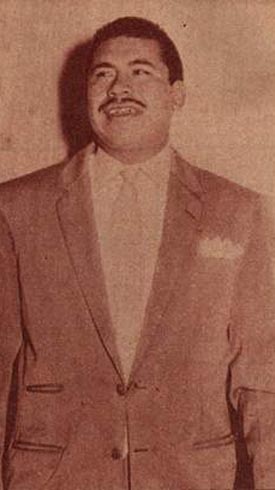Espectro I: Difference between revisions
Tinieblast (talk | contribs) No edit summary |
Rzombie1988 (talk | contribs) No edit summary |
||
| Line 54: | Line 54: | ||
<!-- Gallery Template. Repeat as many times as neccesary --> | <!-- Gallery Template. Repeat as many times as neccesary --> | ||
<!-- Copy all categories that fit --> | <!-- Copy all categories that fit --> | ||
{{Gallery| | |||
|name=HuracanRmzVsEspectroI-PatadasVoladoras.jpg | |||
|caption= Vs Huracan Ramirez}} | |||
[[Category:Deceased wrestlers]] | [[Category:Deceased wrestlers]] | ||
[[Category:Mexican wrestlers]] | [[Category:Mexican wrestlers]] | ||
[[Category:Trainers]] | [[Category:Trainers]] | ||
Revision as of 13:05, 23 December 2006
Profile
| Espectro I (Spectre) | |||||||||||||||||||||||||||||
 |
|
||||||||||||||||||||||||||||
Biography
Antonio Hernández started to wrestle in 1951 as Tony Hernández in Monterrey and didn't make much of an impact during his first years.
One day, the popular referee Roberto "El Güero" Rangel, who was still working selling tickets outside the arenas, bought a magazine called "Los Espectros de Ultratumba" (Spectres from Beyond the Grave). He made a comment to promoter Jesús Garza Hernández, better known as Chucho Garza, and they thought that adapting that spectre character to lucha libre could be a success.
During one of the breaks from the lucha schedule, Garza told Rangel (who was also his secretary) to go to Deportes Martínez in Mexico City (Mexico's most famous maskmaker) and to make an spectre outfit for Tony. All of this happened without Tony knowing about it. And one day Tony was told to use the outfit in Monterrey, and so did he.
He knew that this new gimmick was a good idea, but he hated the outfit. He really hated it. It was too hot under that mask and he felt uncomfortable wearing that green full body suit, but Chucho convinced him not to give up with the promise that he'd make him a big star on a national level.
Espectro's rudo personality and big entrance became a huge attraction soon and his rise to the top of the cards was very fast. He'd come from the locker rooms inside a coffin carried by two men dressed as ghosts or spectres, then they placed it in the ring, and when he came out of the casket, the crowd would explode. He was so good and so over with the crowds, that he got signed with EMLL and in 1954 he became a main feature in the Arena Coliseo and Arena México cards, even though the commission there never let him do his big entrance with the casket while he wrestled in the capital.
Espectro started out as a "heavy welterweight", almost a middleweight, but with the years he became bigger and became a light heavyweight. He was a National Light Heavyweight champion twice as well. Back when there was independent lucha shows at the Cine Politerama, Espectro tried to become an independent wrestler, but that attempt failed and he returned to EMLL.
He also often teamed with Karloff Lagarde, who was one of his two best friends in real life, and he became National tag team champion with Ray Mendoza, who was his other best friend. And even though they didn't win any titles together, his most memorable team partners were the original Karis La Momia and El Espectro II.
At some point during 1959 or 1960, he lost the National Light Heavyweight title to Tarzán López at Arena México, and in a decision that shocked everybody, he unmasked himself, revealed his real name and said that he was retiring.
There was a good reason behind this retirement, though. Days before that retirement, in a match in Tampico against Joe Grant, Espectro injured his neck after receiving a badly executed piledriver, and the doctor ordered him to retire because he needed surgery.
His surgery was quite expensive, and he could not afford it. His friend Karloff Lagarde, who was a wealthy man (all the money earned with lucha libre) offered to pay the 30,000 pesos bill, though in the end, Chava Lutteroth (Salvador Lutteroth's son) said that the Empresa would pay it. The doctor that performed the surgery, Dr. Carrillo, made them a half price so they only had to pay 15,000 pesos plus an extra 3,000 of nursery services. Also while he was inactive, the Union of Luchadores promoted several cards to collect money for Antonio.
He kept draining during his semi-retirement and he came back during the first half of 1962, but without the mask he was not the same, and the Mexico City commission didn't let him wrestle there again due to his bad health, so he stayed around five or six more years wrestling in the smaller arenas and then he retired to become a lucha trainer at the Gimnasio Romano, located at the Vizcaínas street in Mexico City. Some of the wrestlers he trained are the original Espectro Jr. (AAA promoter Antonio Peña), the modern Espectro Jr., his sons Picudo (aka Espectro 2000) and Hijo del Espectro, and non relatives like Clímax I, Clímax II, Voltio Negro and Fuerza Guerrera.
As a curiosity, he always kept in great shape even after retirement as he was an avid practiser of the art of yoga, a hobby he shared with his good friend Ray Mendoza.
He then became a figure of the past and his name was not heard a lot again until he passed away on October 13, 1993 at 7:00 a.m. Mexico City time.
Gallery
 |